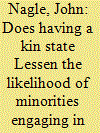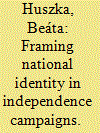| Srl | Item |
| 1 |
ID:
122815


|
|
|
|
|
| Publication |
2013.
|
| Summary/Abstract |
Existing research has demonstrated that the ability of secessionist movements to mobilize is highly contingent on assistance from external actors, especially via transborder ethnic ties. The specific relationship between kin state and kin group is seen as particularly enhancing to opportunities for secessionism/irredentism. Yet, the analysis of data (1989-2011) does not support this claim. Relatively few groups with kin states have engaged in violent secessionism, and these examples are mostly restricted to successor states from Yugoslavia and the Soviet Union. Thus, this article argues that there are a number of reasons why the relationship between kin state and group increasingly engenders moderation. These reasons are the following: the failure of irredentism as a policy and idea; the asymmetric and problematic relations between kin state and group; and the protective capacity and the provision of resources by the kin state. As such, while external help is vital for secessionist groups to successfully mobilize, kin states typically provide assistance that fosters restraint and peace among their kin.
|
|
|
|
|
|
|
|
|
|
|
|
|
|
|
|
| 2 |
ID:
131987


|
|
|
|
|
| Publication |
2014.
|
| Summary/Abstract |
During secessionist mobilization in a multiethnic environment, the use of a discourse that excludes minorities can create internal enemies; meanwhile, co-opting minorities through inclusive framing can turn them into allies. From the standpoint of what sort of identity constitutes the basis of a nationalist movement, my fundamental argument is that the most crucial factor is whether there is a widespread perception of internal threat associated with the presence of a local minority. The chance of such perceptions of a threat emerging among the majority increases if the minority is politically linked to the center or a neighbor that is hostile to the movement. Yet, this explanatory model can show only a tendency depending on the structural setting; it cannot explain the timing and nature of identity shifts. I demonstrate that it is possible to include previously excluded minorities into the national collective through a reframing of national identity, and that the explanation of ethnic exclusion cannot be reduced to a simple ethnic security dilemma.
|
|
|
|
|
|
|
|
|
|
|
|
|
|
|
|